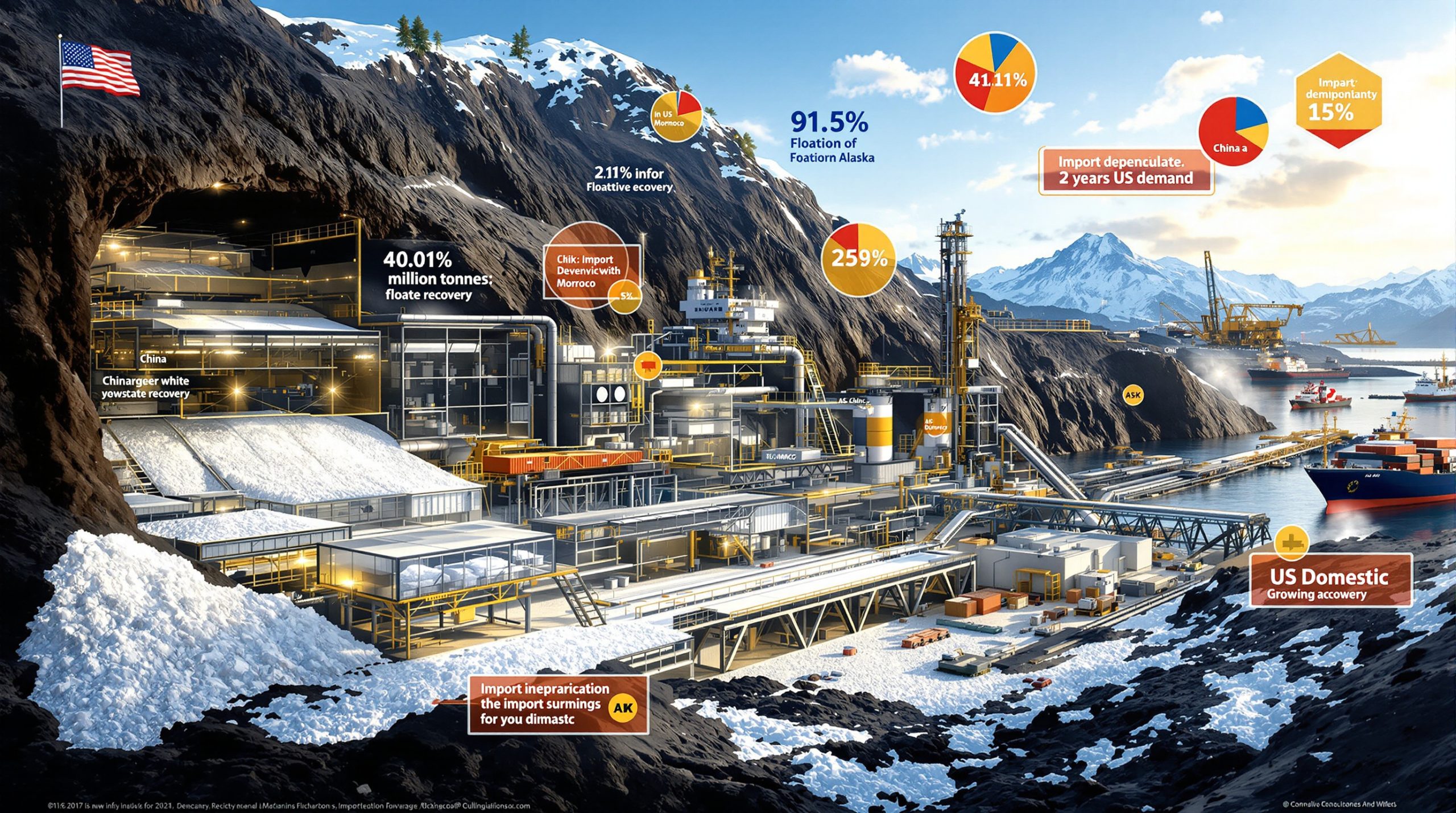Understanding Mineral Sands Market Dynamics: Challenges for Kenmare Resources
The global mineral sands industry is navigating significant headwinds in 2025, with established producers like Kenmare Resources facing complex market conditions. The titanium minerals and zircon sectors are experiencing softer demand, creating challenges that require strategic responses and careful market positioning.
Market Conditions Creating Headwinds
Global demand for mineral sands has notably weakened throughout 2025, with prices declining compared to earlier quarters. This softening reflects broader economic trends, particularly in construction and housing markets where titanium dioxide pigment finds its primary application.
Titanium dioxide pigment, which accounts for approximately 90% of global titanium mineral consumption, has seen reduced demand due to sluggish performance in housing and construction sectors worldwide. According to Grand View Research, the global titanium dioxide market was valued at approximately $19.8 billion in 2023, with construction and architectural coatings representing the largest application segments.
The supply chain currently faces multiple pressure points. Elevated pigment inventories have prompted producers to reduce production rates, which in turn has limited demand for titanium feedstocks. This reduction comes at a time when the supply of titanium feedstocks exceeds demand, creating downward pressure on market pricing.
Chinese Market Dynamics
China, accounting for 30-35% of global titanium feedstock production, plays a pivotal role in setting market direction. After concerning inventory buildup earlier in the year, Chinese pigment inventories gradually decreased through the summer months of 2025.
Recent weeks have shown promising signs with increased Chinese pigment production and price improvements as inventories have normalized to more sustainable levels. This adjustment suggests the potential beginning of market rebalancing, though the recovery remains fragile.
Domestic Chinese ilmenite production and imports of concentrates continue to represent the largest sources of new titanium feedstock supply globally. The U.S. Geological Survey estimates Chinese ilmenite production capacity at 2.5-3.0 million tonnes per year, giving China significant influence over global market conditions.
A notable development in the Chinese market has been the increased availability and acceptance of lower-quality zircon in concentrates, which has negatively impacted overall zircon pricing while creating greater market segmentation between premium and standard grades.
How Is Kenmare Resources Performing Amid These Challenges?
Despite facing significant market pressures, Kenmare Resources maintains confidence in meeting its full-year production and cost guidance for 2025. The company acknowledges the challenging global demand environment but points to operational fundamentals that support its outlook.
Production Performance
Kenmare's third quarter of 2025 saw heavy mineral concentrate (HMC) production reach 298,400 tonnes, representing a 16% year-on-year decrease. This reduction primarily stemmed from a 19% decrease in excavated ore volumes related to a scheduled production pause at Wet Concentrator Plant A (WCP A).
This production decline was partially offset by a 6% increase in ore grades, demonstrating the company's ability to optimize resource extraction during the transition period. The higher-grade material helped mitigate some of the volume impact.
Finished product outputs reflected the lower HMC production:
- Ilmenite production decreased by 19% year-on-year to 209,000 tonnes
- Primary zircon output fell by 16% year-on-year to 12,300 tonnes
- Rutile production decreased by 38% year-on-year to 1,800 tonnes
Notably, concentrates production saw a 58% year-on-year increase to 21,300 tonnes, benefitting from the first commercial shipment of ZrTi – a tailings product that represents Kenmare's product diversification strategy.
Shipping and Logistics Challenges
Kenmare's shipments decreased by 25% year-on-year to 227,400 tonnes in Q3 2025. This reduction was largely attributable to logistical constraints, as the Moma mine operated at only 50% of its normal shipping capacity improvements while the Peg vessel underwent its scheduled five-yearly maintenance in dry dock.
The company's other transshipment vessel, the Bronagh J, delivered strong performance during this period, helping to mitigate some of the shipping capacity reduction.
In an example of responsive management, Kenmare had been exploring the potential rental of a third transshipment vessel to supplement capacity. However, recognizing the lower short-term demand environment, management deferred this additional hiring while keeping the option under consideration for 2026.
What Strategic Developments Are Shaping Kenmare's Future?
Kenmare Resources is implementing significant strategic initiatives to strengthen its long-term market position, with particular focus on the transition to the Nataka orezone – a move that will define the company's production profile for decades to come.
WCP A Plant Transition Strategy
WCP A, Kenmare's largest mining plant, is currently undergoing strategic upgrades ahead of its planned relocation to the Nataka orezone. This preparation work temporarily reduced production in Q3 2025 but positions the operation for future growth.
According to the company's timeline, WCP A will continue ramping up production through Q4 2025 as upgrade work completes. The plant will finish mining its current path in the Namalope area by Q2 2026, at which point the transition process to Nataka will begin.
The move to Nataka represents a significant operational undertaking, expected to commence in late Q2 2026 and require approximately 18 months to complete. This timeline suggests full production from the new orezone would begin around late 2027 or early 2028.
The strategic importance of this transition cannot be overstated. Nataka holds approximately 70% of the entire Moma operation's mineral deposit tiers, securing more than 20 years of future operations. This resource base provides Kenmare with exceptional long-term visibility on production potential.
Product Demand and Sales Outlook
While Kenmare faces near-term demand challenges – including one customer's inability to take contracted volumes in Q4 2025 – the company reports that demand for its products otherwise remains in line with expectations.
The company anticipates strong, high-value zircon sales volumes in Q4 2025, suggesting that premium product segments remain resilient despite broader market softness. Management expects to sell all of its 2025 zircon production and finish the year with low inventories, indicating effective sales strategies and inventory management.
Demand for Kenmare's high-grade zircon has remained stable in both China and Europe, demonstrating the value of quality differentiation in challenging markets. This stability in premium segments occurs despite increased availability of lower-quality zircon in concentrates affecting the broader zircon market.
What Are the Broader Market Trends Affecting Mineral Sands?
The mineral sands market is experiencing significant shifts in supply-demand dynamics, with impacts varying across different product segments and geographic regions.
Titanium Minerals Market Conditions
Global demand for titanium minerals has weakened in 2025, primarily reflecting softer underlying end markets like housing and construction. Industry data shows that architectural coatings represent 50-60% of total titanium dioxide consumption, making the construction sector's health a critical driver of overall demand.
Elevated pigment inventories throughout the supply chain have led to reduced pigment production, which limits demand for titanium feedstocks. This inventory adjustment represents a classic example of the "bullwhip effect" in supply chains, where small fluctuations in retail demand can trigger magnified inventory corrections upstream.
Several major producers are understood to be moderating production in response to these market conditions. However, there remains limited visibility on production responses from small-scale concentrates producers, creating uncertainty about how quickly supply will adjust to current demand levels.
Interestingly, demand for titanium sponge (used in titanium metal production) remained relatively stable throughout Q3 2025. This stability reflects the different demand drivers for aerospace and defense applications compared to construction-related pigment markets.
Zircon Market Dynamics
The zircon market remained subdued in Q3 2025, with limited recovery in end-market demand. Zircon primarily serves specialized markets including ceramics, foundry applications, and zirconium chemicals.
A notable development has been the increased supply of lower-quality zircon in concentrates, particularly affecting the Chinese market. This supply increase, combined with greater customer willingness to accept these lower-grade products, has negatively impacted overall zircon pricing.
Despite this pressure, premium high-quality zircon products have maintained their market position and price differential. This quality segmentation highlights the importance of product differentiation strategies in challenging market environments.
Regional demand patterns show variation, with some markets proving more resilient than others. Kenmare specifically noted stable demand for its high-grade zircon in both China and Europe, suggesting regional and quality-based market segmentation.
What Regulatory Challenges Does Kenmare Face?
Kenmare Resources is managing significant regulatory considerations in Mozambique that could impact its operational framework, with particular focus on the renewal of its implementation agreement.
Implementation Agreement Renewal
Kenmare has expressed concern about the prolonged renewal process of its implementation agreement with the Mozambican government. This agreement is critical as it governs the terms under which the company conducts mineral processing and export activities.
Importantly, the implementation agreement is separate from the mining license itself. The company clarified that the agreement does not impact mining operations at Moma, which are conducted under a separate regulatory framework.
The original implementation agreement had an expiry date of December 21, 2024. Despite the technical expiration, the Mozambican Ministry of Industry and Commerce has provided formal confirmation that Kenmare's existing rights and benefits remain in full force and effect pending conclusion of the extension process.
To address this issue at senior levels, Kenmare's Managing Director met with Mozambique's Minister for Mineral Resources and Energy during Q3 2025. While the meeting demonstrates engagement at ministerial level, the company has not provided specific details on progress toward resolution.
This regulatory uncertainty represents a notable risk factor for Kenmare, though the government's confirmation of continuing rights provides some interim reassurance to investors and operational teams.
How Does the Mineral Sands Supply Chain Function?
Understanding the mineral sands value chain provides essential context for the market pressures facing producers like Kenmare Resources and illuminates the interdependencies that shape market dynamics.
From Mine to Market
The mineral sands supply chain begins with mining and extraction of heavy mineral concentrates (HMC). This initial concentrate contains multiple valuable minerals that must be separated through subsequent processing steps.
After extraction, HMC undergoes mineral separation processes to isolate the valuable components including ilmenite, rutile, and zircon. Each of these minerals serves different markets and applications:
- Titanium minerals (ilmenite and rutile) primarily feed into the titanium dioxide pigment industry, which produces the white pigment used in paints, plastics, and paper
- Rutile and high-grade ilmenite can also serve the titanium metal market via the production of titanium sponge
- Zircon serves specialized markets including ceramics, foundry applications, and zirconium chemicals
Transportation logistics play a critical role in the supply chain, particularly for operations like Kenmare's Moma mine. Specialized vessels for transshipment are essential for moving product from coastal operations to ocean-going cargo ships when deep-water port infrastructure is unavailable.
End-Use Market Dependencies
The construction sector drives approximately half of global demand for titanium dioxide through its use in paints and coatings. This creates a natural cyclicality in the mineral beneficiation opportunities that follows broader construction and housing market trends.
Consumer goods manufacturing, particularly ceramics production, represents the largest end-use for zircon. This creates different demand dynamics compared to titanium minerals, as consumer goods may follow different cyclical patterns than construction markets.
Industrial applications for titanium metal maintain relatively stable demand for high-grade titanium feedstocks, providing some diversification for producers who can supply this segment of the market.
Economic cycles in key consuming regions (China, Europe, North America) significantly impact overall demand patterns. China's outsized role in both production and consumption makes its economic performance particularly influential on global market balances.
What Is the Outlook for Mineral Sands in 2026 and Beyond?
The mineral sands industry faces both challenges and opportunities as it looks toward future market developments, with supply-demand balances expected to evolve over different timeframes.
Short-Term Market Expectations
The supply-demand balance likely remains challenging through early 2026, with current inventory levels and production capacities needing time to adjust to demand conditions.
Chinese market recovery is showing early positive signals through the inventory normalization and production increases noted in recent weeks. As the largest consuming region, China's demand trajectory will heavily influence the global market recovery timeline.
Production adjustments by major producers may help stabilize pricing if sustained and broadened across the industry. The less visible response from small-scale concentrates producers adds uncertainty to how quickly supply will align with current demand levels.
Shipping capacity optimization will be crucial for producers to maximize sales opportunities in a competitive market environment. Kenmare's decision to defer additional shipping capacity while keeping the option open demonstrates the importance of flexible logistics strategies.
Long-Term Industry Fundamentals
Urbanization and infrastructure development in emerging economies will drive long-term demand for both titanium dioxide and zircon products. Population growth and rising living standards create enduring demand for construction materials, consumer goods, and industrial applications that utilize mineral sands products.
Supply constraints may emerge as current price pressures limit investment in new capacity. The capital-intensive nature of mineral sands operations means that sustained periods of low prices can lead to underinvestment, potentially creating future supply shortages when demand recovers.
High-grade deposits will command premium pricing as resource quality generally declines across the industry. Kenmare's transition to Nataka, with its substantial resource base, positions the company advantageously for long-term production of consistent product specifications.
Operational efficiency and cost control will differentiate successful producers in a competitive global market. Companies that optimize production costs and logistics during challenging market periods will be better positioned to capture margin expansion when prices recover.
Mineral Sands Market Indicators 2025
| Product | Price Trend | Supply Status | Demand Trend | Key Market Drivers |
|---|---|---|---|---|
| Ilmenite | Stabilizing after decline | Oversupplied | Moderate | Pigment production, Chinese domestic supply |
| Rutile | Declining | Tight for premium grades | Soft | High-grade pigment, titanium metal |
| Zircon | Declining | Balanced for premium grades | Soft | Ceramics industry, construction activity |
| Concentrates | Declining | Increasing | Variable | Chinese processing capacity, cost pressures |
Navigating Through Market Turbulence
Kenmare Resources mineral sands demand pressures exemplify the challenges facing mineral sands producers in today's market environment. Despite operational adjustments and strategic long-term investments like the WCP A upgrade and Nataka transition, the company must navigate immediate demand pressures, price volatility, and logistical constraints.
The mineral sands industry's cyclical nature suggests that current oversupply conditions will eventually rebalance, particularly as marginal producers respond to price pressures. For well-positioned companies with quality assets and operational flexibility, the current market challenges may ultimately create opportunities for strengthened competitive positioning.
As global construction and manufacturing sectors work through inventory adjustments and economic uncertainties, the fundamental demand drivers for mineral sands products remain intact. The industry evolution trends will depend on how quickly supply and demand return to balance, and how effectively producers can optimize operations during this transitional period.
While near-term headwinds persist, the long-term fundamentals for mineral sands remain positive. Growing urbanization, increasing living standards in emerging economies, and the essential role of titanium dioxide in countless consumer and industrial applications ensure continuing demand for mineral sands products.
Companies with high-quality resources, efficient operations, and financial strength to weather cyclical downturns will be best positioned to benefit when tariff market impact conditions improve. According to the recent production report from Kenmare Resources, the company's focus on the Nataka transition, which secures decades of future production, demonstrates the long-term perspective necessary for success in this cyclical industry. Furthermore, as Mining Weekly reports, despite current market challenges, Kenmare maintains confidence in meeting its full-year guidance targets while acknowledging ongoing demand pressures.
Ready to Spot the Next Mineral Discovery?
Stay ahead of the market with Discovery Alert's proprietary Discovery IQ model, which provides real-time notifications of significant ASX mineral discoveries and transforms complex data into actionable investment insights. Visit the Discovery Alert discoveries page to understand how major mineral discoveries can lead to substantial market returns and position yourself for success in the resource sector.




